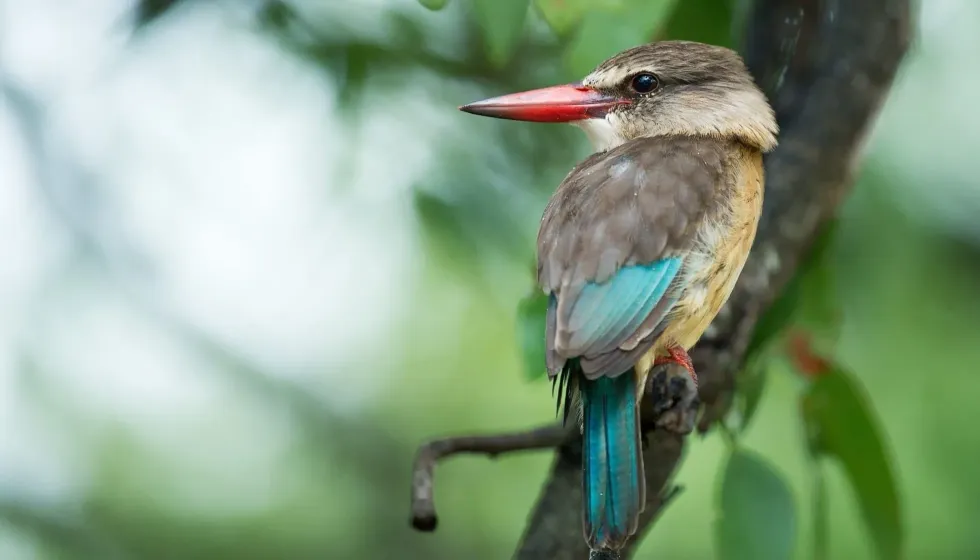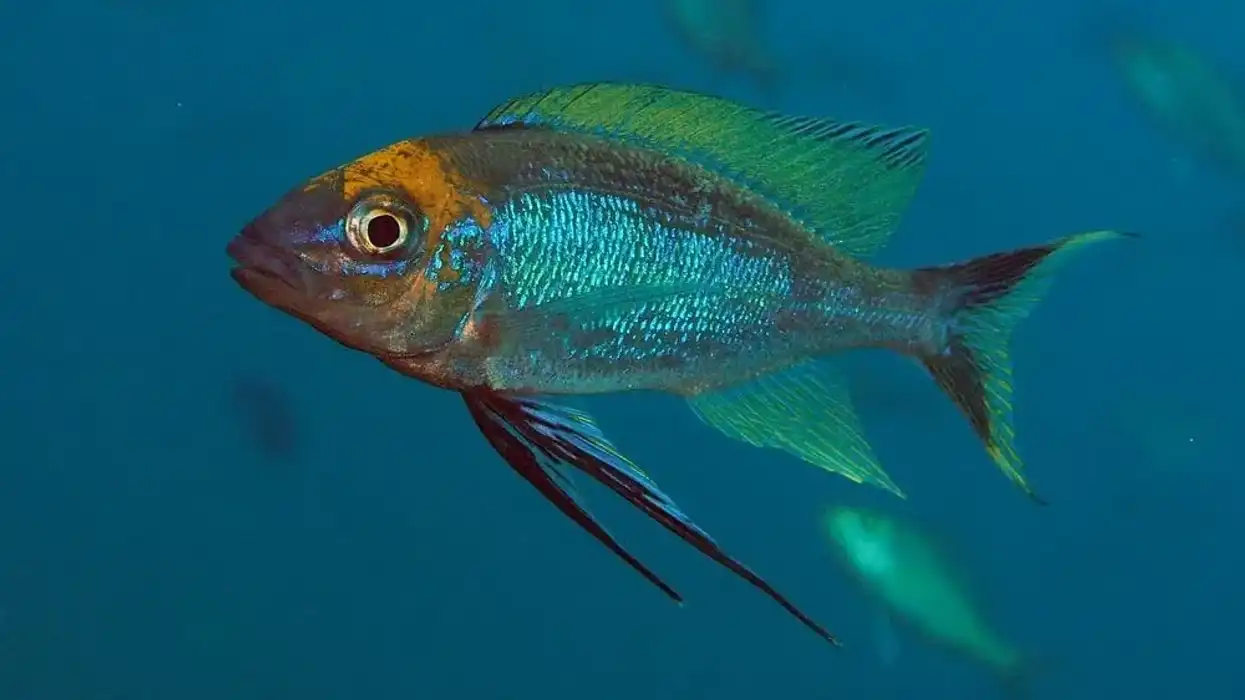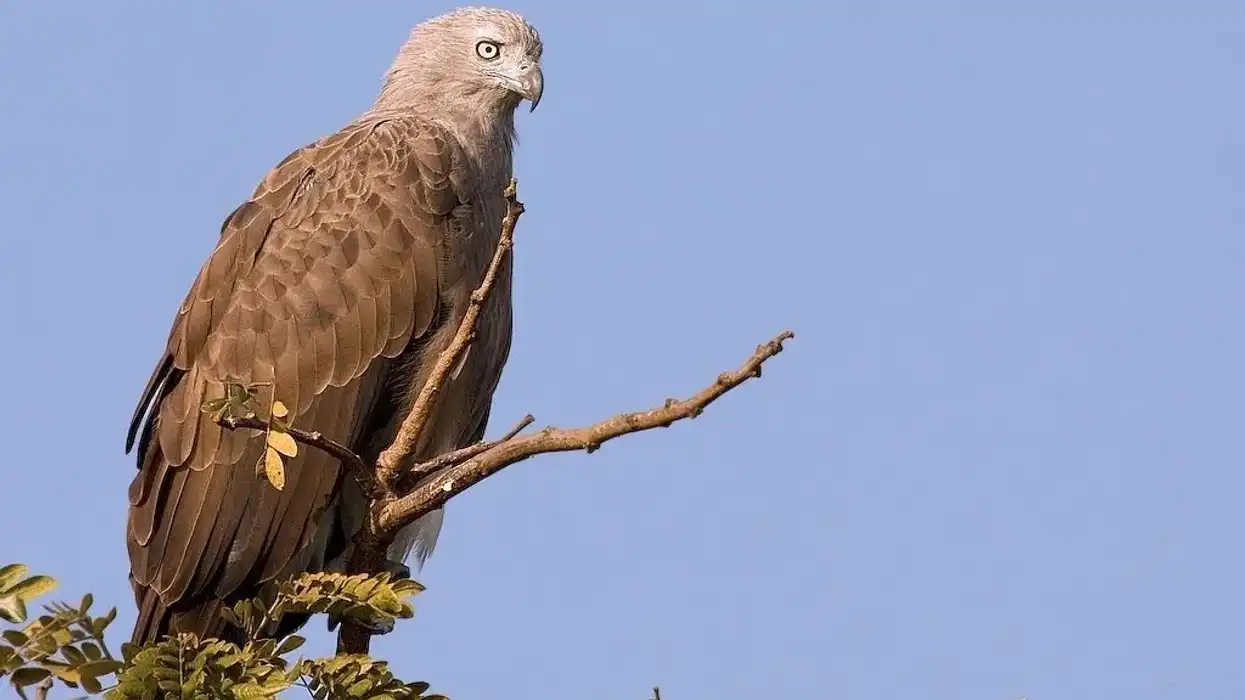The woodland kingfisher, or Halcyon senegalensis as it is scientifically known as, belongs to the Alcedinidae family and genus Halcyon. This kingfisher can be found in Africa.
These birds prefer to live within 8 degrees of the equator. This kingfisher prefers drier habitats.
It can be found in wooded areas like woodlands. They prefer trees in their habitat and have a special preference for the Acacias plant. The breeding season for this kingfisher occurs from November to March in Transvaal and the breeding season happens from November to January in Zimbabwe and Mozambique.
To attract mates, kingfishers produce calls and displays, especially to show their white linings under their wings. The nest of this bird is in holes made by woodpeckers.
In the nest, around 2-3 round and shiny white eggs are laid and incubated for about 13-14 days. The woodland kingfisher, Halcyon senegalensis, has a blue-colored back, wings, and tail.
The head and neck are white in color. Some of them have grayish heads and are often confused with the mangrove kingfisher.
The primary and secondary underwings are black in color and have white coverts. Juveniles have dull colors and a brown bill which is different from the bill of adults. The woodland kingfisher is often solitary but can be spotted in small groups.
It is a noisy kingfisher and its call is a loud trill that has a shrill sound. The calling is more prominent during the breeding season.
It has an interesting way or strategy of seeking food and its food or diet includes insects, arthropods, and sometimes fish, crabs, and frogs. It is quite interesting to know about the woodland kingfisher, Halcyon senegalensis, and if you are interested, read these belted kingfisher facts and common kingfisher facts too.
Woodland Kingfisher Interesting Facts
What type of animal is a woodland kingfisher?
The woodland kingfisher, Halcyon senegalensis is a bird.
What class of animal does a woodland kingfisher belong to?
It belongs to the class of Aves of birds.
How many woodland kingfishers are there in the world?
There has been no exact number of the woodland kingfisher recorded.
Where does a woodland kingfisher live?
The populations of the woodland kingfisher are vastly distributed in Africa and can be found in Sahara and Pretoria. Some woodland kingfishers migrate in the dry season at the night.
What is a woodland kingfisher's habitat?
These birds prefer to live within eight degrees of the equator. This kingfisher prefers drier habitats. It can be found in wooded areas like woodlands. They prefer trees in their habitat and have a special preference for the Acacias plant.
Who do woodland kingfishers live with?
These birds are usually solitary but can be spotted in small groups sometimes.
How long does a woodland kingfisher live?
Woodland kingfishers, or Halcyon senegalensis, are known to live for 6-10 years.
How do they reproduce?
The breeding season for these birds occurs from November to March in Transvaal and from November to January in Zimbabwe and Mozambique. Some of the birds travel or migrate to the Southern part of Africa from October to April to reproduce or breed or mate.
These birds are known to be quite vocal during this time and have displays with calls and wing gestures to display white linings under the wings.
The nest of these birds are holes made by woodpeckers or sometimes can be an old nest of swifts. Around three shiny, white eggs.
Incubation of the eggs takes place for about 13-14 days.
The chicks or the juveniles are taken care of or raised by both males and females and these juveniles or the young ones fledge at about 15-22 or days of age. Juveniles have duller plumage than adults and they have a brown bill, unlike the adults.
What is their conservation status?
The conservation status of the woodland kingfisher is Least Concern.
Woodland Kingfisher Fun Facts
What do woodland kingfishers look like?
This medium-sized kingfisher has a bright blue-colored back, wings, and tail but the shoulders of this bird are black. The head, neck, and underparts or inner sides are white in color.
The breasts of this bird are also white in color. Some of them have grayish heads. The color of the legs and feet is dark gray.
The primary and secondary underwings are black in color and have white coverts. This kingfisher has a large bill and this large bill has a red and black mandible. The upper mandible is red and the lower one is black in color.
There is a dark stripe through the eye of this kingfisher. Both males and females look similar and the juveniles and the young ones are more dull-colored than the adults and are known to have a brown bill.
How cute are they?
The woodland kingfisher is considered cute because of its colors.
How do they communicate?
Not much information is available regarding the communication of this species but just like other birds, they are known to produce calls and sounds to communicate with each other and also make calls and sounds during the breeding season. The call is known to be loud and noisy.
How big is a woodland kingfisher?
This species is known to be sized between a robin and a crow. The length of these birds ranges around 7.8-9.44 in (200-240 mm). These birds are around the same size as a little bee-eater.
How fast can a woodland kingfisher fly?
Kingfishers can fly at a speed of about 25 mph (40 kph).
How much does a woodland kingfisher weigh?
These kingfishers weigh around 0.11-0.17 lb (0.054-0.081 kg).
What are their male and female names of the species?
There are no specific names for males and females of the species.
What would you call a baby woodland kingfisher ?
The baby of a woodland kingfisher is referred to as a chick or young or juvenile.
What do they eat?
This bird feeds on different variety of insects and is also known to eat or feed on arthropods, snakes, and even fish and frogs. Fish and crabs are very rare in this kingfisher's diet or food as this kingfisher does not dive in the water to hunt fish.
This kingfisher, for hunting or preying or seeking food sits in a semi-shade area on a dead branch of a tree. This is unlike other kingfishers like the giant kingfisher who dive into the water for their food.
Are they dangerous?
These birds are not considered dangerous.
Would they make a good pet?
The woodland kingfisher does not make a good pet as it is a wild bird and is not a friendly one and it is difficult to tame a kingfisher. In some areas, it is illegal to own a kingfisher.
Did you know...
This kingfisher is considered to be a noisy kingfisher and its calls are a loud trill.
This kingfisher is territorial and thus, aggressive and tends to attack intruders.
The flight of this kingfisher is known to be rapid, speedy, and direct.
The woodland kingfisher is often confused with the mangrove kingfisher.
Most of the kingfishers have a large head, sharp and large bill, and strong body with shorter legs and stumpy tail.
There are around 87 species of kingfishers in the world.
It is believed that the blue color of the woodland kingfisher and other kingfishers' feathers is not a result of any pigment or something instead it is because of the striking of light on specially modified layers or structures of cells of feathers.
A kingfisher is known to sleep in holes or tunnels.
The woodland kingfisher is an intra-migrant in Africa and migrates or travels throughout Africa in the dry season.
What kingfishers are found in India?
Around 12 species of kingfishers are found in the Indian Subcontinent. Some of them include the blue-eared kingfisher, common kingfisher, pied kingfisher, ruddy kingfisher, brown-winged kingfisher, stork-billed kingfisher.
Species can be found in the foothills of the Himalayas, Eastern, and the Western Ghats. Out of the 12 species of kingfishers found in India, eight of them are found in South India.
What is special about the kingfisher bird?
Kingfishers are considered to be special because almost all the species of kingfishers have bright and colorful plumage. Most of the species are found in tropical habitats and some of them are found in forests.
Here at Kidadl, we have carefully created lots of interesting family-friendly animal facts for everyone to discover! For more relatable content, check out these tinamou facts and black-capped chickadees.
You can even occupy yourself at home by drawing one on our woodland kingfisher coloring pages.










